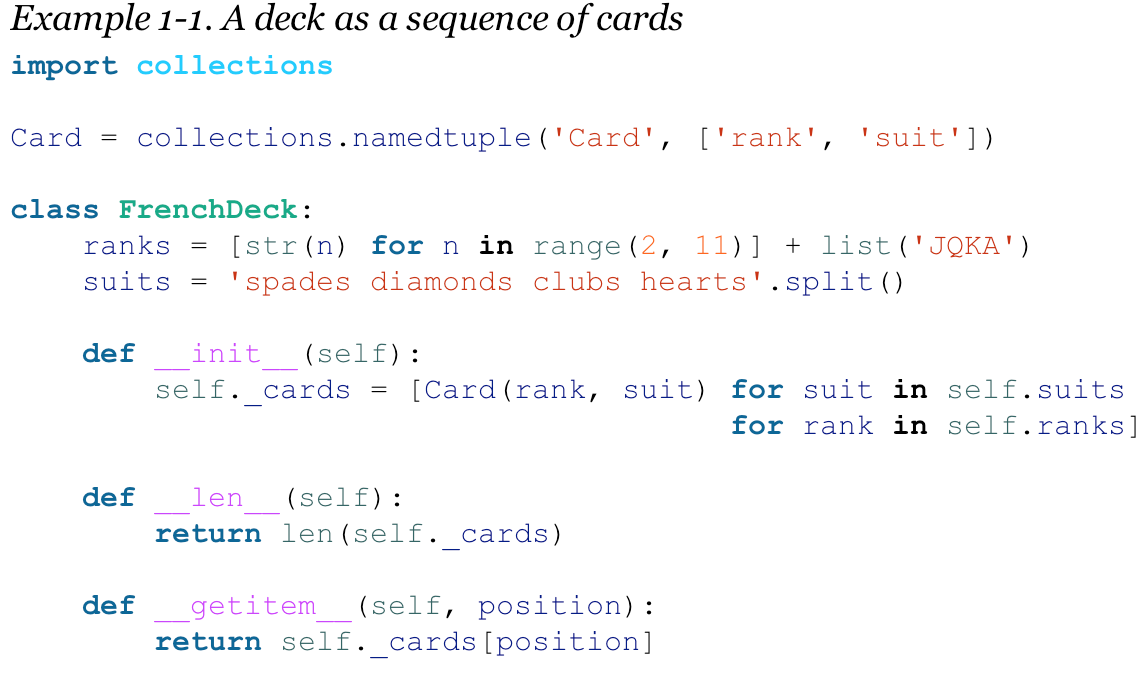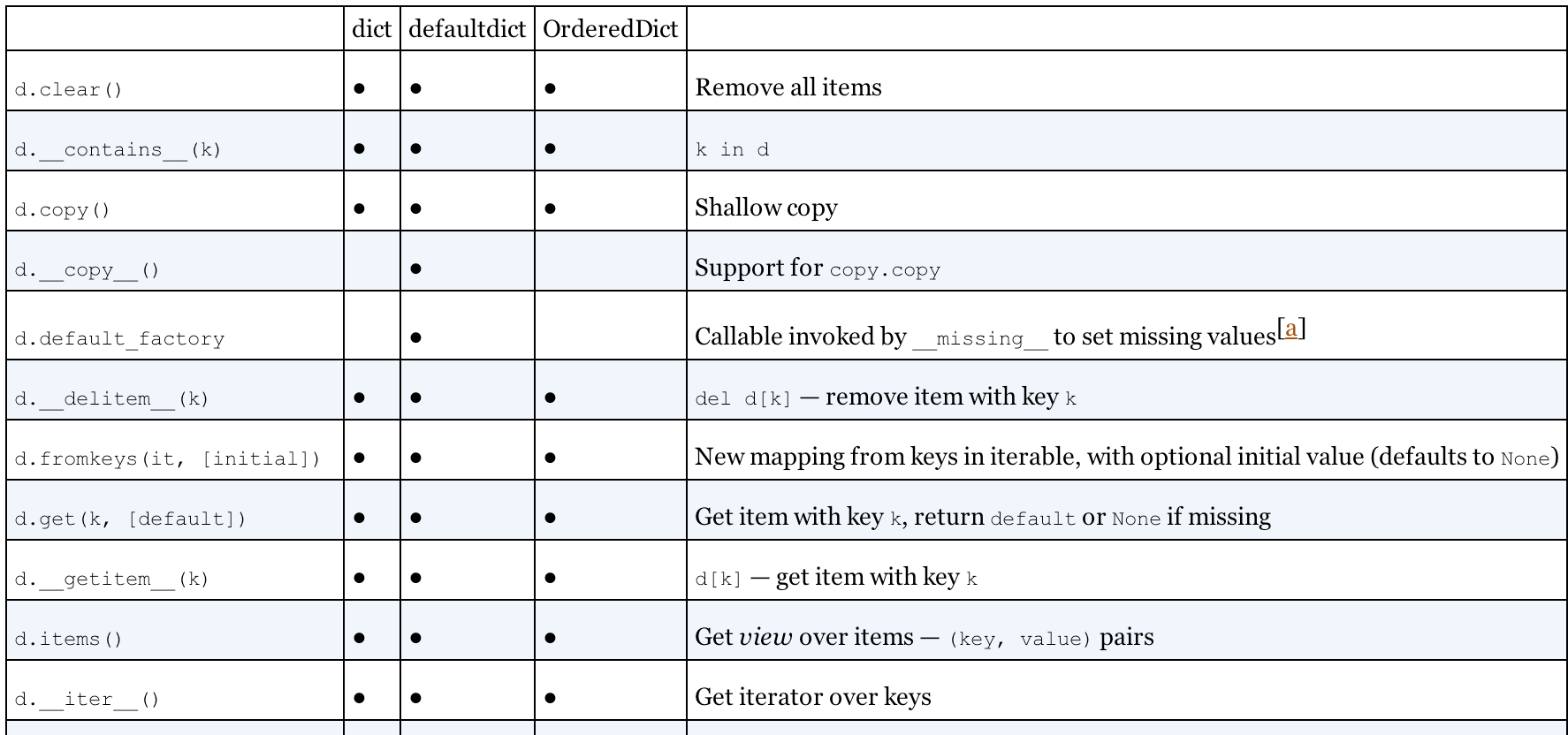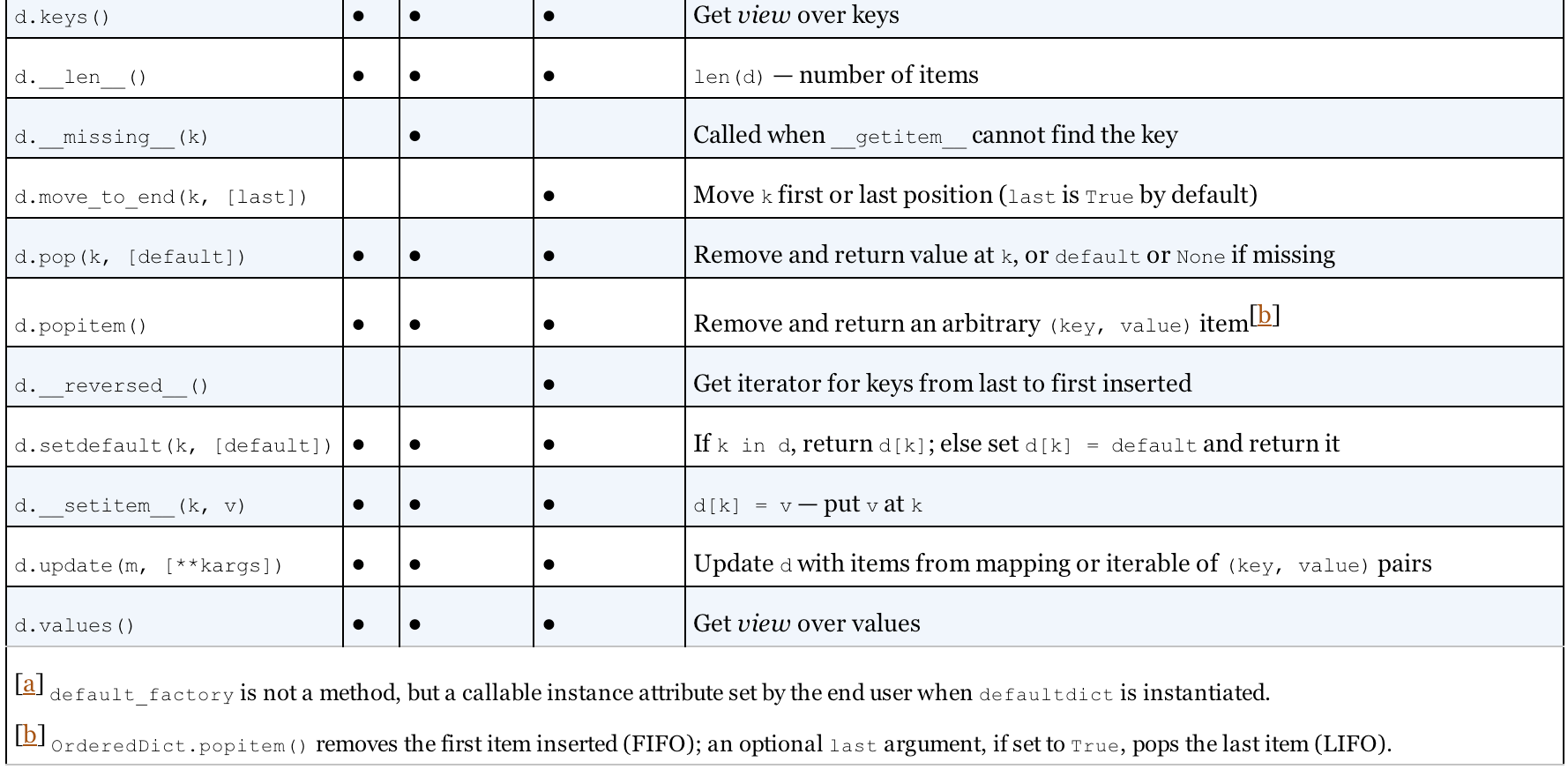These are my notes on “Fluent Python” by Luciano Ramalho. I highly recommend this book for anyone who is comfortable writing applications in Python but would like to get better.
#Chapter 1. The Python Data Model
- the data model formalizes the interfaces of the building blocks of the language (sequences, iterators, functions, classes, context managers, etc)
“…len(collection) instead of collection.len(). This apparent oddity is the tip of an iceberg that, when properly understood, is the key to everything we call Pythonic. The iceberg is called the Python data model, and it describes the API that you can use to make your own objects play well with the most idiomatic language features.
“For example, the syntax obj[ key] is supported by the
__getitem__special method. In order to evaluate my_collection[ key], the interpreter callsmy_collection.__getitem__( key).
- “experienced Pythonistas” use the term “dunder method” to refer to methods like
__getitem__, and would pronounce it “dunder-getitem”

- namedtuple can be used to build classes of objects that are just bundles of attributes with no custom methods, like a database record
- defining
__len__for FrenchDeck means that after you create an instance you can utilize the data model’s standard len(deck_instance) - defining
__getitem__means that you can utilize deck_instance[-1] or deck_instance[0], etc - since FrenchDeck has
__len__and__getitem__methods, it can utilize Python’s built-in methods for sequences, like random.choice:random.choice(deck) - just by implementing
__getitem__, our deck now supports slicing, iteration sorting,Card('Q', 'hearts') in deck, etc. - “The only special method that is frequently called by user code directly is
__init__, to invoke the initializer of the superclass in your own__init__implementation” - Example 1-2 is a Vector Class that utilizes
__repr__,__abs__,__bool__,__add__and__mul__to support Python’s built-in number methods



Conclusion: “By implementing special methods, your objects can behave like the built-in types, enabling the expressive coding style the community considers Pythonic.”
#Chapter 2. An Array of Sequences
- “Strings, lists, byte sequences, arrays, XML elements, and database results share a rich set of common operations including iteration, slicing, sorting, and concatenation”
-
“Understanding the variety of sequences available in Python saves us from reinventing the wheel, and their common interface inspires us to create APIs that properly support and leverage existing and future sequence types.”
- container sequences
- hold items of different types
- e.g. list, tuple, collections.deque
- hold references to the containing objects
- flat sequences
- hold items of one type
- e.g. str, bytes, bytearray, memoryview, array.array
- physically store the value of each item in their own memory space
- mutable sequences: list, bytearray, array.array, collections.deque, memoryview
- immutable sequences: tuple, str, bytes
- list comprehensions are more explicit than for-loop constructs, because list comprehensions are meant to do only one thing
- “Listcomps do everything the map and filter functions do, without the contortions of the functionally challenged Python lambda”
Generator Expressions
- similar to list expressions for building tuples, arrays and other types of sequences
- e.g.
tuple(ord(symbol) for symbol in symbols) - use the same syntax as listcomps, but are enclosed in parentheses rather than brackets
Tuples
- Not just “immutable lists”
- can be used also as records with no field names
- “each item in the tuple holds the data for one field and the position of the item gives its meaning”
- “when using a tuple as a collection of fields, the number of items is often fixed and their order is always vital”
- “Tuples work well as records because of the tuple unpacking mechanism”
- collections.namedtuple is a factory that produces subclasses of tuple enhanced with field names, a class name and some extra attributes / methods
Tuple unpacking allows you to:
- elegantly swap values w/o a temporary variable:
b, a = a, b - prefixing an argument with a star when calling a function:
t = (2, 4);add(*t) - grabbing excess items in Python 3: a, *body, c, d = range( 5)
- perform nested tuple unpacking:
for name, cc, pop, (latitude, longitude) in metro_areas:will give access to latitude and longitude as individual values of a tuple inside of metro_areas
Slicing
- slicing operations “are more powerful than most people realize”
- slice and range exclude the last item
- “It’s easy to see the length of a slice or range when only the stop position is given: range( 3) and my_list[: 3] both produce three items”
- “It’s easy to compute the length of a slice or range when start and stop are given: just subtract stop - start”
- “It’s easy to split a sequence in two parts at any index x, without overlapping: simply get my_list[: x] and my_list[ x:]”
- case: s[ a:b:c] can be used to specify a stride or step c, causing the resulting slice to skip items
- ‘bicycle’[::3] => ‘bye’
- ‘bicycle’[::-1] => ‘elcycib’
- ‘bicycle’[::-2] => ‘eccb’
- “Mutable sequences can be grafted, excised, and otherwise modified in place using slice notation on the left side of an assignment statement or as the target of a del statement” :
- l = range(10)
- l[2:5] = [20, 30]
- l is now [0, 1, 20, 30, 5, 6, 7, 8, 9]
- del l[5:7]
- l is now [0, 1, 20, 30, 5, 8, 9]
Sorting
- “functions or methods that change an object in place should return None to make it clear that the object itself was changed, and no new object was created”
- list.sort sorts a list in-place and returns None
- sorted accepts any iterable object, creates a new list and returns it
- bisect( haystack, needle) does a binary search for needle in haystack — which must be a sorted sequence - to locate the position where needle can be inserted while maintaining haystack in ascending order.
- “An interesting application of bisect is to perform table lookups by numeric values - for example, to convert test scores to letter grades”

- “An interesting application of bisect is to perform table lookups by numeric values - for example, to convert test scores to letter grades”
- Sorting is expensive, so once you have a sorted sequence, it’s good to keep it that way. That is why bisect.insort was created.
- insort(seq, item) inserts item into seq so as to keep seq in ascending order
Alternatives to Lists
- If the list will only contain numbers, an array.array is more efficient
- The built-in memoryview class is a shared-memory sequence type that lets you handle slices of arrays without copying bytes -“A memoryview is essentially a generalized NumPy array structure in Python itself (without the math). It allows you to share memory between data-structures (things like PIL images, SQLlite databases, NumPy arrays, etc.) without first copying. This is very important for large data sets.”
- collections.deque is a thread-safe double-ended queue designed for fast inserting and removing from both ends (its expensive to move left-sided items from a list)
- “It is also the way to go if you need to keep a list of “last seen items” or something like that, because a deque can be bounded — i.e., created with a maximum length — and then, when it is full, it discards items from the opposite end when you append new ones.”
Chapter 3. Dictionaries and Sets
- the dict type is a fundamental part of Python: module namespaces, class and instance attributes and function keyword arguments use them
- hash tables are the engines behind dicts and sets
Methods of the mapping types dict, collections.defaultdict and collections.OrderedDict; optional arguments are enclosed in […]


“The way update handles its first argument m is a prime example of duck typing: it first checks whether m has a keys method and, if it does, assumes it is a mapping. Otherwise, update falls back to iterating over m, assuming its items are (key, value) pairs.”
- setdefault is convenient if you want to update the value of a key that may not exist yet:
books.setdefault('sci-fi', []).append('anathem') - the defaultdict class or a mapping-type class with
__missing __overridden are other ways to handle missing keys in a mapping object (e.g. to convert numeric-key lookups to strings before the lookup in a project that deals with circuits and allows looking up numbers for convenience)
Alternatives to dict
- collections.OrderedDict maintains keys in insertion order
- collections.ChainMap “holds a list of mappings that can be searched as one”
- collections.Counter holds an integer count for each key
>>> ct = collections.Counter("abracadabra")>>> ct- => Counter({‘ a’: 5, ‘b’: 2, ‘r’: 2, ‘c’: 1, ‘d’: 1})`
- collections.UserDict
- used to create new mapping types, as its more convenient to extend than the standard
dict
- used to create new mapping types, as its more convenient to extend than the standard
- types.MappingProxyType builds an immutable mappingproxy instance from a dict
Set Theory
- there is set and there is the immutable frozenset
- “a set is a collection of unique objects”
- elements in a set must be hashable
- the union, intersection, difference and other mathematical operators can be determined between multiple sets
- counting occurrences of needles in a haystack for any iterable:
len(set(needles) & set(haystack)) s = {1}creates a sets = {}creates an empty dicts = set()creates an empty set-
set comprehensions:
{chr( i) for i in range( 32, 256) if 'SIGN' in name( chr( i),'')} - dicts and sets are fast, and use hash tables under the hood
- “If your program does any kind of I/ O, the lookup time for keys in dicts or sets is negligible, regardless of the dict or set”

#Chapter 4. Text versus Bytes
“Humans use text. Computers speak bytes” - Esther Nam and Travis Fischer
“This chapter deals with Unicode strings, binary sequences, and the encodings used to convert between them.”
To be continued…
#Chapter 5. First-Class Functions Functions are “first-class objects” and therefore can be:
- created at runtime
- assigned to a variable or element in a data structure
- passed as an argument to a function
- returned as the result of a function
- in other words, functions are objects
- higher-order functions are functions that take other functions as arguments
- there are seven callable objects in Python:
- user-defined functions
- built-in functions implemented in C, like
lenortime.strftime - built-in methods like
dict.get - methods of classes
- classes
- class instances, if they define a
__call__method - generator functions
- arbitrary Python objects can be made to behave like functions if you define a
__call__instance method for them


#Chapter 6. Design Patterns with First-Class Functions
‘Although design patterns are language-independent, that does not mean every pattern applies to every language. In his 1996 presentation, “Design Patterns in Dynamic Languages”, Peter Norvig states that 16 out of the 23 patterns in the original Design Patterns book by Gamma et al. become either “invisible or simpler” in a dynamic language’
This chapter runs through some implementations of the Strategy and Command design patterns. I don’t feel comfortable summarizing it: it’d be a good idea to read through this chapter a few times a year.
Chapter 7. Function Decorators and Closures
“The end goal of this chapter is to explain exactly how function decorators work, from the simplest registration decorators to the rather more complicated parameterized ones.”
- decorators run right after the decorated function is defined (usually at import time)
- a good use of decorators is to register some function as belonging to a group without needing to define it as part of the group in another part of the code base
- for example, if there are multiple “promotion” types (bulk-item discount, good-customer discount) in an e-commerce application written as functions, you can apply a @promotion decorator to the functions, and create an inventory at runtime, rather than having to account for each function name individually
- closures: functions that can access nonglobal variables that are defined outside of its body